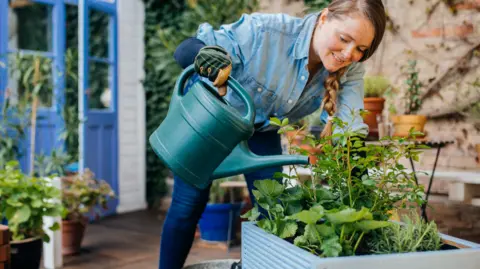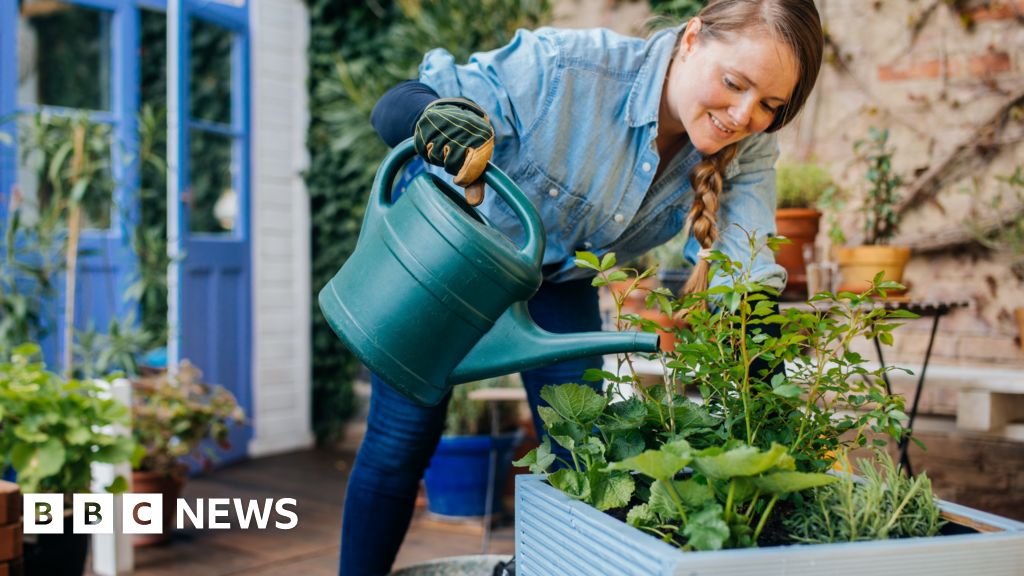 Getty Images
Getty ImagesWith parts of the UK expected to reach 29C on Thursday, this week’s spring heatwave will undoubtedly have an effect on plants – both inside and outdoors.
Experts say that while the unusually warm weather this early in the year could pose some issues for some plants, others stand to benefit and flourish.
Indoor plants will need protecting, and trees could suffer – but outdoor plants may thrive if watered properly, in particular those producing fruit.
Here’s what the experts we spoke to had to say about the warm weather – and what they advise green-fingered folk do to make the most of it.
Indoor plants
Increased temperatures and too much direct sunlight can have a negative effect on houseplants.
Signs like wilting, drooping, or changing colour could indicate that the heat is getting to your beloved leafy greens.
Conservatories and greenhouses, similarly, can get too hot unless shading is provided, Guy Barter, the Royal Horticultural Society’s chief horticulturist, told the BBC.
“Houseplants can scorch in bright sunlight unless moved back deeper into rooms where there is more shade.”
He suggested providing additional shading from now until September to prevent heat damage.
If space is a factor, using a sheer curtain can also help mitigate the impacts of direct sunlight.
Fruits and veggies
The warmer than average start to May is already having a noticeable affect on the timing of this year’s harvest, according to Pauline Goodall, a strawberry farmer from Limington in Somerset.
In the past week, she told BBC Breakfast her small farm had gone from filling three to four trays of strawberries a day to 50.
“They’re just ripening at a phenomenal rate.”
Helena Dove, head of Kew Gardens’ kitchen garden, said they had also already seen ripe strawberries – and that this was a trend for other fruits being grown in the UK.
“Traditionally, a good kitchen gardener would be proud to have ripe strawberries by Wimbledon,” she told the BBC.
However, Mr Barter cautioned that while the days were warmer, night time temperatures were still relatively low, limiting the “helpful” effects of the warmth.
He said the risk of frost would pass in the south soon, allowing “frost-tender plants” such as dahlias and tomatoes to be planted outside.
Outdoor plants
During times of hotter weather, outdoor plants and flowers will typically require more water than usual.
That’s particularly true for plants that have recently been put in the ground, according to Tony Hall, the head of Kew Gardens’ temperate collections. He told the BBC it was essential that they are well watered “to encourage a deep root system”.
“Hot weather tends to weed out plants that are in poor health and already struggling, but this can present an opportunity to plant something that is more drought tolerant,” he said.
Mr Barter said newly sown seeds and recently planted vegetables, flowers and shrubs will need “careful watering” until they grow their roots out enough.
But he added that more warmth and extra light earlier in the year “helps them send out strong roots to counter any drought later in the summer”.
For both indoor and outdoor plants, the advice is to water in morning or evening, but not in the middle of the day when the water will evaporate quickly.
Trees
At this time of year, trees are enter into their leaf expansion phase – a process that demands substantial physiological resources, including water.
Kevin Martin, Kew Gardens’ head of trees, explained that the recent warmer weather – coupled with an existing soil moisture deficit – is creating a “worrying” situation.
If these conditions persist, he warned it could hamper a tree’s ability to carry out photosynthesis, reducing growth and leaving them exposed to further decline over the summer.
Mr Martin suggested planting “better-suited species” of trees that have “greater built-in resilience as we experience more extreme conditions”.
What should I plant for future warm weather?
This recent bout of warm weather is because of a fluctuation in the jet stream – a river of fast-flowing air that tends to divide warmer air close to the equator from colder air further north – bringing warm air up from the Mediterranean.
While scientists say climate change is making these fluctuations more erratic, how much influence climate change has on particular weather events requires a full scientific study.
Paul Hadaway, from Kent Wildlife Trust, told the BBC that the spring heatwave was part of a larger trend of “seasonality breaking down”.
“Last year we had a mild winter, warm spring and then we had a wet summer – and that’s not good for wildlife that’s learned to adapt to a certain climate pattern,” he told BBC Breakfast.
He said people in the UK could mitigate the negative effects of this seasonal breakdown by rethinking “how we manage our naturals areas”, including planting new species that are better accustomed to these extreme swings.
Ms Dove, of Kew’s kitchen garden, said that while “traditional” fruits like apples were struggling, “the warm spring means crops like citrus, kiwi, and tropical plants are thriving earlier, with longer seasons and better yields”.
She added: “We’re even growing peaches, apricots, and nectarines outside currently, something that would have been unthinkable in previous years due to the risk of late frosts and lack of early pollinators.”
Meanwhile, the RHS says species of oak and ash tree could be more adaptable to withstand extreme changes in the seasons.
